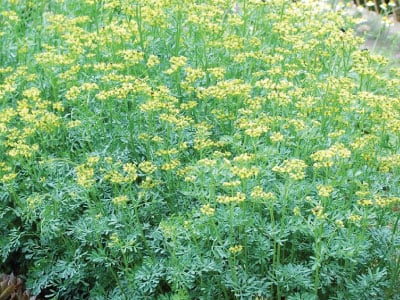
Learning Download: How to Grow Rue
From Seed to Harvest: A beginner’s guide to growing rue
Rue is a very old-fashioned garden herb not commonly seen. Although rarely grown anymore, it is usually grown for medicinal reasons only. Rue is a hardy perennial with yellow blossoms and fern-like, blue-green leaves. In the past, the herb was used medicinally as an antispasmodic to treat neuromuscular problems. It is now known that medicinal uses for rue can even be dangerous and even toxic, but the plant’s strong scent can repel many pests and make it a good companion plant in the garden. The rye herb is semi-woody and can be pruned. The herb can reach up to 3 feet tall. In addition to deterring smaller pests, it also deters deer from the garden.
To plant:
Once temperatures reach 70 degrees on average, it is time to plant rue. Find a barren area of the garden in full sun with well-drained soil and turn the soil with a shovel. Rake it smooth. Scatter rue seeds across the surface of the soil and then gently press the seeds into the soil with your hands. The seeds should germinate in up to 28 days.
To grow:
Prior to sprouting, mist the soil with a mister. Once seedlings are 4 inches tall, thin them to 18 to 24 inches apart. Rue grows best in well-drained soil and will even grow in rocky, dry soil where other plants struggle to survive. Rue requires full sun to grow and is drought tolerant so it rarely needs watered. Add a mulch of hay or cut up leaves around the plants to control weeds and retain water. Water deeply every three weeks. Over-watering can cause root rot.
During its growing season, remove and discard any branches or leaves that become a different color or wilt. In the fall, cover the plants with 24 inches of protective mulch, such as leaves. Although the plant is very hardy, it does require winter protection. In the spring, cut back the branches, as this encourages new growth.
To harvest:
Take care when harvesting rue, as its sap can irritate the skin and leave rashes. Once harvested, rue can be used as an insect repellant. To do so, cut and dry the leaves and then place the dried leaves in cloth bags to then spread around the house.
What rue craves:
Rue doesn’t require amendments to the soil prior to planting as it is a very hardy plant. In the early spring, once new growth begins, apply a complete fertilizer with equal portions of nitrogen, phosphorous and potassium. Use a granular fertilizer and apply 2 pounds of fertilizer per each 1,000 feet of soil.
Where to buy rue seeds:
You can find rue seeds at Urban Farmer.

